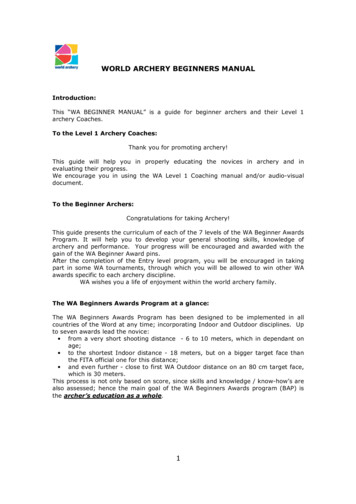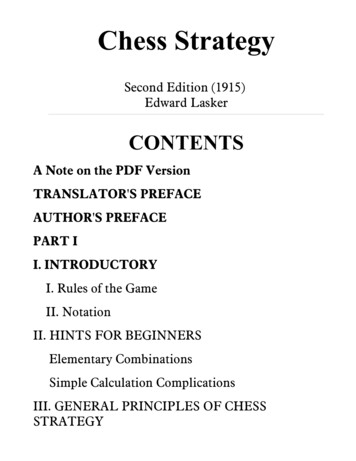
Transcription
Bosonization for BeginnersLectures given by Jan von DelftSchool on Low Dimensional Nanoscopic SystemsHarish-chandra research InstituteAllahabad, IndiaJan 28 - Feb 9, 2008Jan von DelftLudwig-Maximilians-Universität Münchenwww.theorie.physik.uni-muenchen.de/ lsvondelftInternships - Summer Research Programwww.nano-initiative-munich.de/summerMasters programme in Theoretical and Mahematical national Doctorate Program lIn 1D, "bosonizationrelations" of thefollowing form hold:Goal of lectures:- explain origin of these relations- illustrate them with some canonical examplesOutline:I.1D-fermions, 1D-bosonsII. Bosonization identityIII. Impurity in Luttinger LiquidIV. Kondo modelPopular applications1. Interactions in 1DLiterature:- Bosonization for Beginners - refermionization for experts,Jan von Delft & Herbert Schoeller,Ann. Physics 7, 225-306 (1998), cond-mat/9805275- Simple Bosonization Solution of the 2-channel Kondo Model: I. AnalyticalCalculation of Finite-Size Crossover Spectrum,Gergely Zarand and Jan von Delft,Phys. Rev. B. 61, 6918 (2000) [including appendices: cond-mat/9812192]- Interacting fermions in one dimension: The Tomonaga-Luttinger modelK. Schönhammer, cond-mat/9710330(pioneered by: Luttinger, Schotte & Schotte, Mattis &Lieb, Luther & Peschel, Haldaneapplications: Kane & Fisher, Wen, Shankar.)Since fermions in 1D cannot pass each other, interactions are "strong" and dramaticallychange the physics (e.g. spin-charge separation)Applications:nanotubesorganic moleculessemiconductor quantum wiresInteractions in 1D:Kinetic energy:Interacting model becomes exactly solvable!quantum Hall edge states
2. Impurity models (Kondo):(Emery & Kivelson, '92)Spin-flip term:Bosonize:New boson field:Refermionize:Heuristic plausibility argument for bosonization relationHow can it be true that:For 1-D bosons, withlinear dispersion:For 1-D fermions, withlinear dispersion:or, using (1):standard identity forbosonic operators:using (2):
Questions:How general is (5.1) ?Does (5.1) rely on linear dispersion?On what Fock space ?Is (5.1) an operator identity?Commutation relations?Several speciesof electrons?Role of cut-offs ?Infrared:Ultraviolet:Finite-size effects?Outline of lecture I: 1-D fermions & bosons1. Linearization of fermion spectrum2. Properties of 1d fermion fieldsI.1 Linearization of fermion spectrum4. Normal ordering5. Density fluctuations - bosonic excitations(ignore spin)replace/approximate byadd positron states withfor L/R-brancheslinearization is justified:curvature-effectNeglected terms [order (k/kF)] describe curvature effects: current research topic!Fermi-Luttinger liquid: Spectral function of interacting one-dimensional fermions, Khodas, Pustilnik, Kamenev, Glazman, PRB, 76, 155402 (2007)
Replacing (6.1) by (6.2) is justified if we are interested only in long-wavelength / low/energyproperties, withanyway, i.e. in excitation energiesIn this case, we may as well send cutoffand replace theoryCorresponding approximation for electron fields, step by step:Drop high-energy excitations, assuming theydon't matter for low-energy properties:Step 1: drop BI.2 Properties of 1d fermion fieldsCutoff means: new fieldscan resolvespatial structures only if they are coarser thanStep 2: to get a mathematically simpler, cleaner theory,now take cutoff to infinity, i.e. add "positron states"(since they did not matter for low excitation energies anyway):(x is smeared on scale a)So, write:Impose anti-periodicboundary conditions:(convenient to avoid degeneracyof Fermi ground state)
Anticommutators:Continuum limit:(finite bandwidth)convention of vDSsmeared delta-functionOr:infinite bandwidthantiperiodic delta-functionLinearized kinetic energy:Fermi ground state:Imaginary-timeevolution:If we ever need realtime evolution:Fermion field:
I.3 Imaginary-time-ordered fermion correlator at T 0a regularizesthe correlatorfor z 0For finite L one finds, usingI.4 Fermion normal orderingTo bring " normal order" a product of operators,move all operators that annihilate the vacuum to the right of all others,and multiply by (-1) for each exchange of two fermion operators.For product of two operators,this is equivalent to:Example:By definition, vacuumexpectation value of twonormal ordered operators
I.4 Fermion normal orderingTo bring " normal order" aproduct of operators,subtract their vacuumexpectation value:Equivalently: move all operators that annihilate the vacuum to the right of all others,and multiply by (-1) for each exchange of two fermion operators.Example:By definition, vacuumexpectation value ofI.5 Density fluctuations - bosonic excitations(2 pi) density:bilenear, hence bosonic in character!Fourier representation:i.t.o. density modes:where we defined:Particle number relativeto Fermi ground state:Momentum lowering op:(Bosonic annihilation op)Momentum raising op:(Bosonic creation op)Note: (5) and (6) are automatically normal ordered, hence no need to write[the q 0 term of (2)]
Bosonic commutation relations:(for notational simplicity, below we drop the index)momentum-loweringoperator does not changeparticle numberSimilarly:ifif, both terms are normal-ordered, so we can sethere, obtaining, both terms have to be normal-ordered first, before reaarranging sum; this gives:number of possible transitionsgenerated bycancel after shift in first term:
6. Properties of 1d Boson fields"annihilation field":"creation field":The ultraviolet cutoff a here acts as a bandwidth for bosonic excitations.In fermion language, it sets the maximum momentum difference between particle/hole pairs.Hermitian boson field:Derivative gives density:(provided a 0)Compare (16.4) &(13.3):Boson field commutators:(for notational simplicity, below we drop the index)Note: this commutator needs both infrared and ultraviolet regulators, 1/L and a,
Commutator of phi with its derivative(but retain 1/L term)The 1/L term ensures consistency upon integrating (1):since phi is periodic, (16.1, 16.2)Commutator of phi with itself[can be obtained by integrating (18.1)]fixed by requiringcommutator tovanish for x x'smeared step functionwhere(4) is the form most often quoted, with a 0, L infinity.
Bosonization for Beginners Lectures given by Jan von Delft School on Low Dimensional Nanoscopic Systems Harish-chandra research Institute Allahabad, India Jan 28 - Feb 9, 2008 In 1D, "bosonization relations" of the following form hold: Goal of lectures: - explain origin of these relations - illustrate them with some canonical examples Jan von Delft










